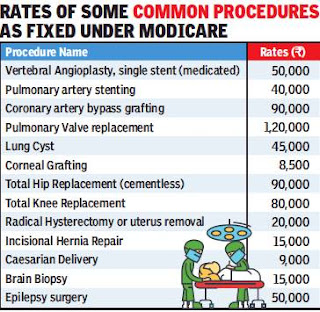
Modicare to offer treatment upto 20% less than CGHS rates :-
In a move likely to set new pricing standards for medical procedures in the country, The National Health Protection Scheme (NHPS), popularly known as Modicare, will offer common treatments such as coronary bypass, knee transplant and C-section at a rate which is around 15-20% lower than the Central Government Health Scheme (CGHS).
CGHS provides healthcare to government staff, pensioners and dependants. The health ministry has finalised the rates for 1,354 packages to be covered under NHPS. The packages include 23 specialties, such as cardiology, ophthalmology, orthopaedics, urology and oncology, an official said.
Low prices list under Modicare :-
- For instance, the rate for vertebral angioplasty with single stent has been fixed at Rs 50,000, whereas that with double stent will cost Rs 65,000. Similarly, the price for total knee replacement is fixed at Rs 80,000, whereas a caesarean section will be charged at Rs 9,000.
- The list also includes paediatric surgeries, different packages for cancer treatment as well as mental disorders.
- For comparison, an angioplasty would cost about Rs 1.5-2 lakh, a C-section around Rs 1.5 lakh and a total knee replacement would set a patient back by around Rs 3.5 lakh in any of the reputed private hospitals in Delhi.
About :-
- The NHPS rate list is part of a model tender document for the Pradhan Mantri Rashtriya Swasthya Suraksha Mission.
- The document, finalised after consultation with Niti Aayog and Indian Council of Medical Research (ICMR).
- Also details the minimum number of days of hospitalisation required to make a claim as well as pre-surgery and post-surgery investigations needed for approval.
- The document has been shared with state governments for comments. It will also be circulated among the bidding insurers by the states.
WHO launched 5 year plan for Universal Health Coverage :-
Delegates at the 71st meeting of the World Health Assembly, a decision-making body of the World Health Organisation (WHO), agreed to an ambitious strategic plan on health for five years.The WHO’s 13th General Programme of Work discussed at the assembly in Geneva is designed to help the world achieve the Sustainable Development Goals – with a particular focus on SDG3 which seeks to ensure healthy lives and promoting wellbeing for all at all ages by 2030.
The plan has three targets - to ensure that by 2023 :-
- One billion more people benefit from universal health coverage
- One billion more people are better protected from health emergencies
- One billion more people enjoy better health and wellbeing.
Delegates, including India, represented by Health Minister JP Nadda, noted that the WHO will need to make some strategic shifts to achieve these targets
- Notably to step up its public health leadership
- Focus on impact in countries and ensure that people can access authoritative and strategic information on matters that affect people’s health.
Now the debate at the assembly turned to the WHO’s work in emergencies.
- Over the coming days, the delegates will make decisions relating to the International Health Regulations (2005) which relates to timely notification of outbreaks and emergencies, the Pandemic Influenza Preparedness Framework, non-communicable diseases; cholera, tuberculosis; snakebite; physical activity; digital health; assistive technology; polio virus; and health conditions in the occupied Palestine territory.
- It will also discuss other topics, including access to essential medicines and vaccine and women’s, children’s and adolescent’s health.
India to move resolution on digital health :-
- India will move the first global resolution on digital health at the ongoing World Health Assembly.
- It will host the world's first conference on digital health later this year.
- Health Minister JP Nadda told the gathering at Geneva that India will also host the second global conference on medicine and medical products in October this year.
Cabinet clears ordinance for changes in IBC :-
The Cabinet on Wednesday approved promulgation of an ordinance to amend the 16-month-old Insolvency and Bankruptcy Code (IBC), which proposes to classify homebuyers as “financial creditors” at par with lenders to help them quickly get refunds from defaulting companies.
The amendment comes months after a new Section 29A was added into the bankruptcy code in November, introducing four layers of ineligibility for potential bidders. The present amendment is based on recommendations of a 14-member government appointed committee that had last month suggested a slew of measures, including addressing woes of home buyers and making recoveries easier for lenders.
The IBC provides for a market-determined and time-bound insolvency resolution process.



Post a Comment